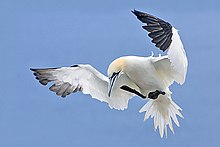Suliformes
| Suliformes Temporal range: Late Cretaceous? - present |
|
|---|---|
 |
|
| Northern gannet (Morus bassanus) | |
| Scientific classification | |
| Kingdom: | Animalia |
| Phylum: | Chordata |
| Class: | Aves |
| Clade: | Aequornithes |
| Order: |
Suliformes Sharpe, 1891 |
| Families | |
The order Suliformes (dubbed "Phalacrocoraciformes" by Christidis & Boles 2008) is an order by the International Ornithologist's Union. In regard to the recent evidence that the traditional Pelecaniformes is polyphyletic, it has been suggested that the group be split up to reflect the true evolutionary relationships.
Of the families in Pelecaniformes, only Pelecanidae, Balaenicipitidae, and Scopidae remain. The tropicbird family Phaethontidae has since been moved to their own order Phaethontiformes. Genetic analysis seems to show that the Pelecaniformes is actually closely related to the Ardeidae and Threskiornithidae. As for the Suliformes, they are distantly related to the current Pelecaniformes. According to the Hackett et al. (2008), loons, penguins, storks, and as well as Suliformes and Pelecaniformes, all seem to have evolved from a common ancestor. The proposed waterbird superorder has been suggested.
In their landmark 2008 work Systematics and Taxonomy of Australian Birds, Australian ornithologists Les Christidis and Walter E. Boles coined the name Phalacrocoraciformes for the group due to the much greater number of species of cormorants (Phalacrocoracidae) over boobies and gannets (Sulidae). However, this has not been taken up elsewhere.
In 1994, American ornithologist Walter J. Bock wrote that the name Suloidea had been used consistently as a term for a superfamily containing the two families, so therefore "Sulidae" and not "Phalacrocoracidae" should take priority in any arrangement containing the two genera.
In 2010, the AOU adopted the term Suliformes for the taxon. The IOC followed in 2011.
...
Wikipedia
